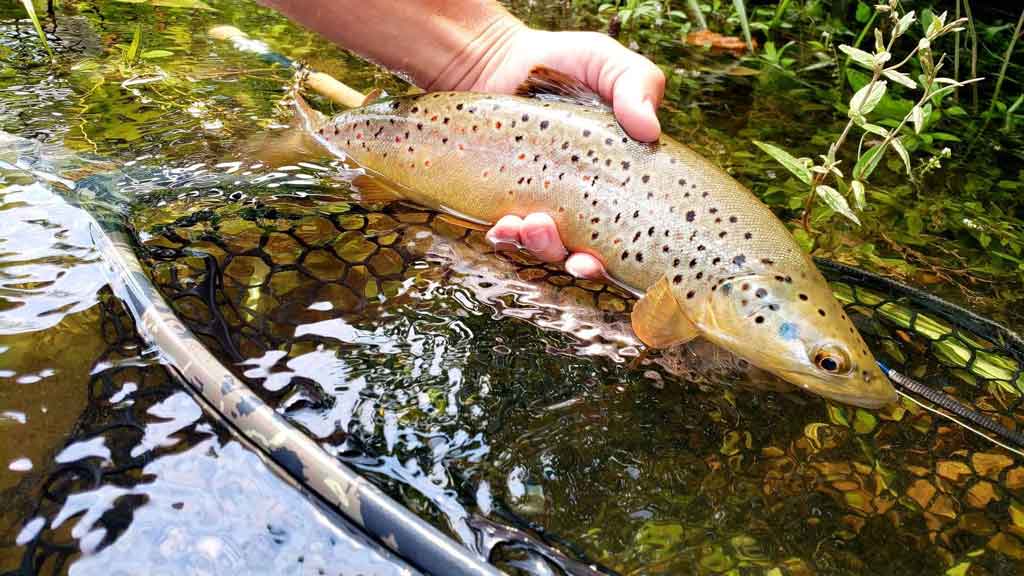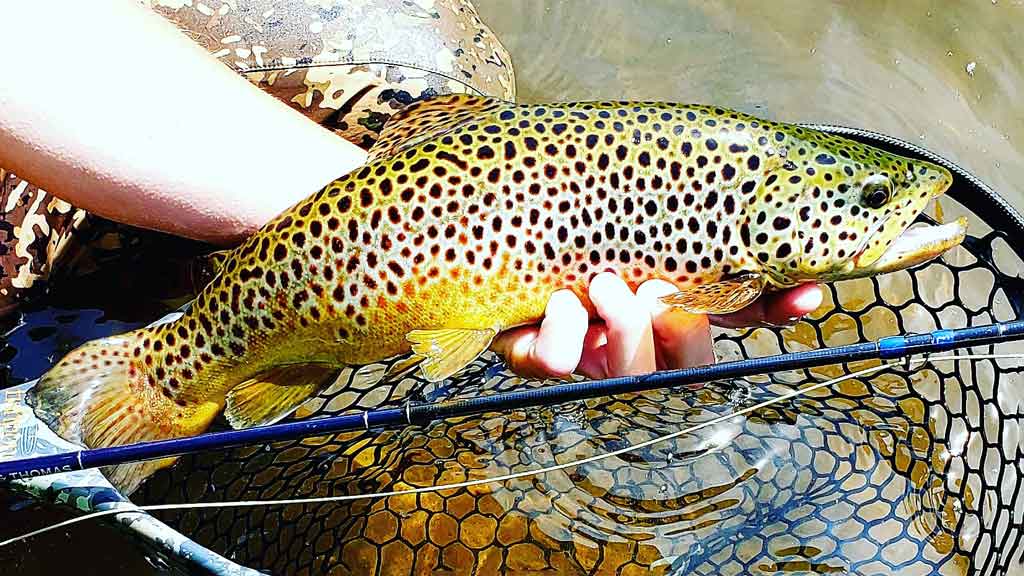Fly fishing is a sport that has been around for centuries. The first written account of fly-fishing dates to 1653, when Izaak Walton described it in his book "The Compleat Angler." Fly fishermen have been catching and releasing fish ever since the 18th century!
As a general rule catch and release is practiced to ensure a healthy fish population for future anglers. By returning your catch to the wild, you are giving another angler the opportunity to do the same.
In addition to a healthy fish population below are 5 additional reasons why catch and release is practiced by fly fisherman.

1. Gives Young Fish a Chance To Grow
Anyone can practice fly fishing, and it's not just about catching fish. Many people fly fish for the sheer enjoyment of being out on the water.
But many anglers catch trout or other species they intend to keep. They do so because they don't want to let them go back into the river/lake where somebody else might snag one before they get another chance at it or because their freezer has room for only so much ice-fishing bait. But most will release what they catch as soon as possible.
The reason for doing this is to ensure that the fish has a chance to grow into adulthood and reproduce. Fly fishing during spawning season or in areas where you are stocking the trout can put pressure on the local population of small fish, causing them not just to be less likely to survive as adults or to reproduce.
It also limits how much larger adult trout will exist farther downriver. You can do this by reducing their number too much when they're young, so fly fishers often release any catch for future enjoyment.

2. To Adhere to the Fishing Limit
All anglers are required to adhere to the fishing limit. For fly-fishermen, it means releasing fish after catching them so they can live a long and happy life in their natural environment. The fishing limit is critical because it helps maintain the health of our rivers, streams, and lakes, and all the fish populations.
As a rule, fly-fishermen don't keep anything from their catch. They release all of them back into the water after taking photos and inspecting them thoroughly. The fishing limit is in place so that you can enjoy catching and releasing these beautiful creatures without worrying about overfishing.
The fishing limit rule says that you can catch and keep a certain number of fish each year or outing depending on your locality. Each region limits the number of fish you can fish at a particular water source, depending on the projected number of fish. It would be unfortunate if you depleted the fish population without any hopes of having more fish in the future.
On the flip side, certain fish populations can become invasive and the Fish & Game department might require you to keep all of these types of species that you catch to ensure a healthy ecosystem.
Check with your local ordinance and location before heading out to the water for all regulations.

3. Older Fish Might Have More Pollutants in Their System
Many people ask why fly anglers catch and release. The answer is simple: older fish might have more pollutants in their system, which, as you may know by now, are not suitable for humans to ingest, especially when it comes to the consumption of raw or undercooked seafood.

Fly fisherman typically uses a barbless hook or crimp down their hooks so that they can quickly remove from any sized fish without causing injury. In addition, many states require anglers who want to keep what they caught to do so only after getting the appropriate fishing license, meaning no one knows if those lovely salmon fillets came from an end-of-season stocking project or not! Besides keeping the food supply safe and ensuring you're following conservation guidelines while on the water, it just feels better to release the fish.
Older fish are also less palatable because of their high levels of mercury. Fly fishers believe that catching and releasing a fish has as much or even more significant an impact on the fishery than keeping one for dinner. Many fly fishers believe that catching a fish, releasing it, and then fishing for another one will have the most beneficial impact on that fishery. Research suggests that these actions may even help the fish population grow and be healthier than ever!
4. Improves the Angling Experience in Future Outings
The reason fly fishers catch and release is for the sake of improving future fishing expeditions. Catching fish, only to let them go, ensures more fish will be available in subsequent fishing trips.
There's no sense in worrying about how many you'll get when you're out trying to have fun, be glad to have one (or two, or three). Fly fishing is about the experience and not just catching fish. You might even find that you get more enjoyment out of having a few trout on the bank than if you saw them all day but never had time to stop.
Experience matters with this type of angling, you're going after something different from what your friends are doing, so it's best to do things differently, too!
5. Serves a Management Tool
Fly fishing is an activity that many enthusiasts enjoy. One of the reasons they do it, and what they want about fly fishing, is because it can serve as a management tool for fish populations in certain areas where there are too many adult trout or other species.
Not catching these adults (usually by releasing them) will allow younger fish to grow into adulthood so more anglers can experience their beauty firsthand. In addition, catch-and-release helps ensure future generations will be available for those who want to keep trying new adventures with this sport.
The idea of catch-and-release has been around for many years. Still, at the turn of the century in 2000, there was a significant shift where more and more fly fishers were coming to understand why it is an important management tool. In 2001 alone, nearly 40% of all trout reported taken from some waters were released back into those same bodies.
You need to remove these fish with care and understanding that they are now part of the fishing club. They are not just a trophy mounted on a wall or put behind glass cases at grocery stores. Then you will see even greater success for the conservationists.
What you are doing is not just for the sport of fly fishing but also to help ensure that future generations will enjoy the same experience. Without proper management, these water bodies may not sustain the populations you all enjoy today, which means it will be even more difficult for future generations to get out and enjoy what you have today.
Therefore, it is crucial to understand that it is also your responsibility as fly fishermen and conservationists to ensure that everyone acts responsibly and uses your skills as anglers to the best of your abilities. Being responsible will keep our sport alive and ensure that future generations have the same opportunity to get out and enjoy nature.
Catch-and-release is a good conservationist's tool because it helps maintain healthy fish populations for anglers and ensures they are doing their part as stewards of the environment where these water bodies exist.
Conclusion
Catch and release is a good thing so long as you are doing it responsibly. It teaches kids to respect the animal, helps keep the fish population healthy, gives people who don't have time for fishing with their children something fun to do.
There's no need to be worried about catching too many trout or other species of fish because there will always be plenty in the ocean! Catch and release also make sure you get more variety out on your plates which is exciting and new for people to try.
The negative is that if you're not doing it responsibly, the fish will die in a net or onshore, and other animals might get sick from eating them. You can prevent this by using barbless hooks so they can't swallow the bait or just throwing them back into the water alive without touching their mouth. If someone doesn't release an animal responsibly, then there's also a chance of losing its natural habitat, which is another downside because plants are essential too!

About the Author
Matthew Bernhardt, a third-generation Coloradan, grew up at the forefront of the state’s fly-fishing revolution, enjoying time on the water, side by side with experienced guides and lifelong anglers.
By combining his passion for fly-fishing with input from other experienced fly-fishers and guides and his fine arts degree from Colorado State University, Matthew spent five years carefully developing the Drifthook Fly Fishing System, built to help every angler catch more trout.
When he’s not spending time with his wonderful family, you’ll find him out on the water catching MONSTER trout, and he anxiously looks forward to the day when his kids are old enough to join him there.








1 comment
Chris Burgess
This article is far from accurate. Fly fisherman keep their catch. I guess it depends where you live. I go fishing for salmon trout etc. Some rivers are catch and release only. What fly fishing does however is allow you to release a fish unharmed. Even though I keep fish when a limit is retained it allows us to fish more.
This article is far from accurate. Fly fisherman keep their catch. I guess it depends where you live. I go fishing for salmon trout etc. Some rivers are catch and release only. What fly fishing does however is allow you to release a fish unharmed. Even though I keep fish when a limit is retained it allows us to fish more.